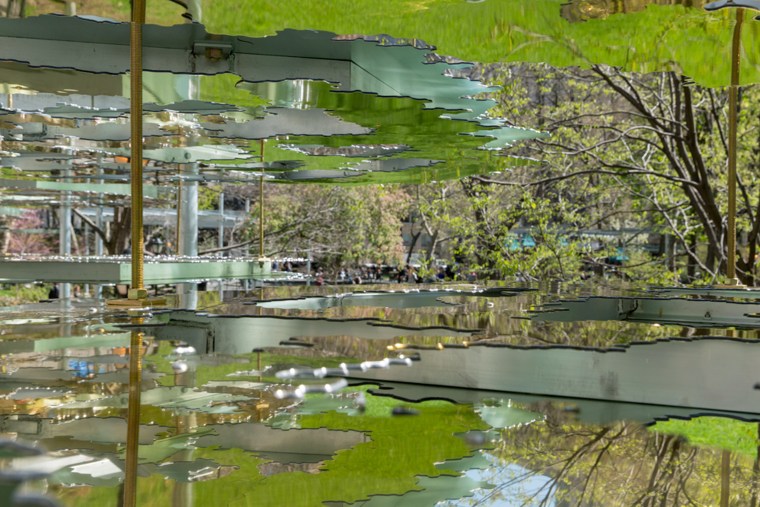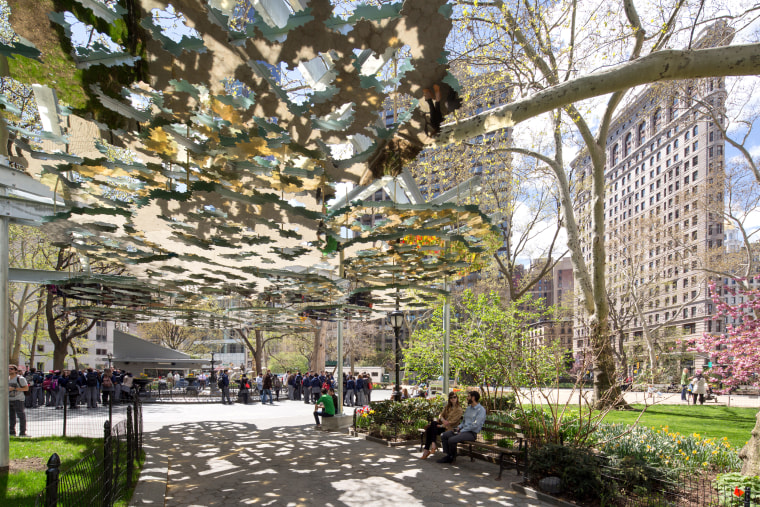NEW YORK, NY -- When I first happened upon "Fata Morgana" by Teresita Fernández in New York City's storied Madison Square Park, I wasn’t sure what I was seeing. From its profile, the extensive and immersive piece - a 500-foot-long sculpture installed horizontally above park visitors in 6 sections - practically disappears into the trees.
But as I walked underneath it, the gold-sculpted sheets of metal transformed not only the walkways, but everything it reflected. The multi-layered and overlapping industrial gold fauna managed to reflect the hovering trees, the sky and the pathways it covered. It simultaneously made me feel as though I was making my way through a fantastical man-made garden and the most organic setting in the world.
Mesmerized by the experience, I wanted to know everything about its creation. Recently I spoke with Teresita Fernández and learned a little about the process that went into creating the mirage.
NBC: What inspired your Fata Morgana?
TF: When the park first approached me to do an artwork at Madison Square Park I knew I didn’t want to place something in the middle of the oval, instead I wanted to utilize the walkways which are really a kind of microcosm for the arteries of movement throughout New York City. I was interested in making a work that would become an immersive experience where people could see themselves on the move as they walk becoming part of the work in that way.
NBC: How did Madison Square Park factor into its creation?
TF: This artwork itself is very site specific. It has to do with the place we’re standing in. I started thinking about it by trying to peel back the layers of where we are. When I’m approaching a site specific artwork is I ask myself where I am, where I am physically, where I am historically, where I am politically, culturally. Where is the place we’re standing in and how does it exist in our imagination as well. This site is important because of the flat iron building which is right to the left. When it was built in 1904, it was the tallest building north of 14th street. In many ways, the site we’re standing on is where the idea of looking up in this city (which is essentially a vertical city) was first encountered. So I was interested in creating an artwork that forced people to look above their heads, to explore that space above the walkways, which is a space we often take for granted even though we live in this very vertical city.

NBC:What have you observed as people walk through that has stayed with you?
TF: Well, what’s interesting about art in public spaces is that the public really sort of takes over and uses it in ways that you didn’t anticipate. It’s one of the things I like most about working with spaces that are very democratic that people take over somehow. I’ve seen language classes in the middle of the pathway, dances classes, groups of people coming together sort of using the space underneath the canopies almost like an outdoor room.
NBC: Can you speak to the tension between the materials and the environment. The heavy gold sheets of metal that look like lace contrast and reflect seemlesly with the fragile but massive foilage of the trees.
TF: The title of the piece is Fata Morgana. Fata Morgana is a kind of mirage that appears in nature as this sort of optical illusion of like a floating landscape above the horizon. I was fascinated with this idea of how a mirage abstracts nature. On this very grand scale a I could create an artwork this very big object in a sense that would distort and reflect and refract the images of the daily commute and urban life. These mirrored canopies overhead. Part of the challenge for me is how do you make this 500 foot long, several ton object that is about appearing and disappearing ethereality. That starts to happen even though its very big it kind of disappeared in certain lights and certain times of the day. The piece will change throughout the seasons and depending on the angle of the sun, so sometimes its very somber on an overcast day. On a day like today the pathways light up with a golden reflection. In a way the piece almost becomes like a barometer of the tone of the city and the tone of the day and people are invited to be immersed in whatever that is.
NBC: Does your experience as a Cuban-American factor into the artwork at all?
TF: Fata morgana is a reference to a poem that Andre Breton wrote in 1942 which was illustrated by the Cuban artist, Wilfredo Lam. I knew who Lam was from a very early age and I was always very interested in how there was a sense of camouflage in Lam’s work where the figures are essentially camouflaged into the landscape. They’re integrated, they’re fractured, they’re fragmented within the landscape and in many ways this piece actually does that. In much of my work, Ive played with these concepts of the visible and the invisible and the idea of how something can be hiding in plain sight. This large object can essentially dissolve into an ephemeral, non presence.

NBC: What has been the most exciting aspect of having your work featured so prominently in the heart of the city?
TF: One of the things that’s been very gratifying for me about having this huge work in the middle of New York City is that I could use my own visibility in taking up this big site to influence some of the programming that occurs in the park. On Saturday, I did a collaboration with Yesenia Seller a scholar and performer of Afro Cuban culture she and her group of dancers and musicians did an amazing event underneath the Fata Morgana. I’m also working on a Spanish language poetry event and a few other events that really aim to take this place that I’ve claimed with this object of Fata Morgana and create a context around it with the programming.
Fata Morgana will be up through the winter of 2015 at Madison Square Park in New York City.